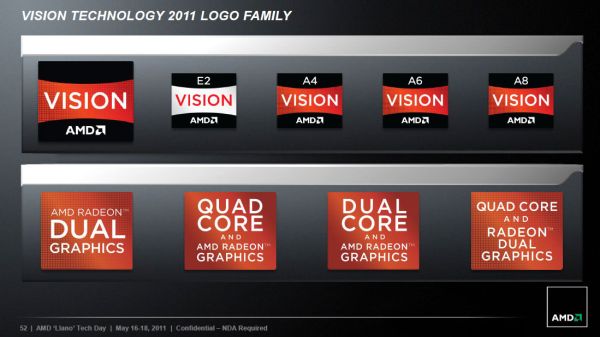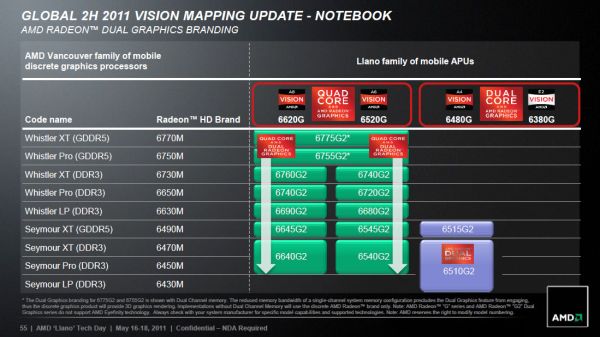The AMD Llano Notebook Review: Competing in the Mobile Market
by Jarred Walton & Anand Lal Shimpi on June 14, 2011 12:01 AM ESTIntroducing Mobile Llano
Anand has provided our coverage of Llano’s architecture and he’ll have a preview of desktop performance, but he’s leaving the mobile coverage to me (Jarred). At a high level, the breakdown of Llano is really quite simple: take a K10.5 series CPU core (dual- or quad-core), pair it up with a DX11 capable GPU core similar to AMD’s Redwood line (5600/5600M or 6500M), and then mix in power gating and Turbo Core; bake everything in a 32nm process and you’ve got Llano. Easier said than done, of course, as K10.5 parts previously used a 45nm process while Redwood used 40nm, so AMD had plenty of work to do before they could realize the simplistic overview I just described; the result is what matters, though, so let’s break out our spoons and see how the pudding tastes. Here’s the overview of the mobile A-series APUs launching today.
| AMD A-Series Fusion APUs for Notebooks | |||||||
| APU Model | A8-3530MX | A8-3510MX | A8-3500M | A6-3410MX | A6-3400M | A4-3310MX | A4-3300M |
| CPU Cores | 4 | 4 | 4 | 4 | 4 | 2 | 2 |
| CPU Clock (Base/Max) | 1.9/2.6GHz | 1.8/2.5GHz | 1.5/2.4GHz | 1.6/2.3GHz | 1.4/2.3GHz | 2.1/2.5GHz | 1.9/2.5GHz |
| L2 Cache (MB) | 4 | 4 | 4 | 4 | 4 | 2 | 2 |
| Radeon Model | HD 6620G | HD 6620G | HD 6620G | HD 6520G | HD 6520G | HD 6480G | HD 6480G |
| Radeon Cores | 400 | 400 | 400 | 320 | 320 | 240 | 240 |
| GPU Clock (MHz) | 444 | 444 | 444 | 400 | 400 | 444 | 444 |
| TDP | 45W | 45W | 35W | 45W | 35W | 45W | 35W |
| Max DDR3 Speed |
DDR3- 1600 DDR3L- 1333 |
DDR3- 1600 DDR3L- 1333 |
DDR3- 1333 DDR3L- 1333 |
DDR3- 1600 DDR3L- 1333 |
DDR3- 1333 DDR3L- 1333 |
DDR3- 1333 DDR3L- 1333 |
DDR3- 1333 DDR3L- 1333 |
There are two different power envelopes for Llano right now: 35W and 45W. The former models end with an M while the latter end in MX. Don’t let the relatively high TDPs fool you, as similar to Intel we’re looking at maximum TDP while idle and low-load TDP will be far lower. Based on battery life, it appears that the entire test notebook consumes around 7.42W at idle. By comparison, a slightly larger dual-core SNB notebook consumes around 7.68W when idle, so we’re very close to parity at idle. As noted earlier, all APU models come with 1MB L2 cache per core, and Turbo Core allows for cores to clock up to higher values under the right circumstances. That could prove important, as clock-for-clock K10.5 cores can’t hope to keep up with Sandy Bridge, and Sandy Bridge parts are already clocking significantly higher.
On the CPU side of the equation, there are currently only dual-core and quad-core parts, so tri-core appears dead (or at least MIA for now). The other part of the APU is the GPU cores, and here there are three options. The A6 and A8 APUs are both quad-core, but A6 has 320 Radeon cores clocked at 400MHz compared to 400 cores at 444MHz—so the 6620G is potentially 40% faster. A4 APUs trim the GPU further, with 240 cores clocked at 444MHz, and they’re the dual-core parts. The 6620G could be up to 67% faster than 6480G, under the right circumstances. As Anand mentioned, right now all of the A-series APUs are coming from the “big Llano” die, but in the future we’ll see the A4 production shift to “little Llano” instead of using harvested die.
Vision and Radeon Branding
For 2011, AMD is simplifying their Vision branding with Llano, skipping the Premium, Ultimate, and Black modifiers and instead referring to the APU. Vision E2 refers to the dual-core E-series APUs, while the A4, A6, and A8 lines correlate directly with the A-series APUs. The Radeon brand continues as an important asset, so there will be sticker options to promote quad-core and dual-core CPUs with Radeon graphics. What about the Dual Graphics, though?
With the integrated GPU finally able to approach the performance of midrange mobile GPUs, AMD is making a return to hybrid CrossFire (IGP and a dGPU working together), though the official name is now apparently “Radeon Dual Graphics” or just "Dual Graphics"; we’ve also heard it referred to as “Asymmetrical CrossFire”, and we’ll use any of these terms throughout this article.
We first saw an attempt at hybrid CrossFire with the HD 2400 and the 790 chipset, and later that extended to HD 3400 cards, but it never really impressed as it was limited to desktops and you could still get far better performance by spending an extra $10 to upgrade from a 3400 to a 3600 dGPU. The 6620G fGPU is several times more powerful than the old HD 4250 IGP, making CrossFire potential useful, especially on laptops where the power savings from shutting off the dGPU are very significant.
With Radeon Dual Graphics, AMD introduces more brands. The various Fusion GPUs (fGPUs) only work in CrossFire with specific discrete GPUs (dGPUs)—nearly all of the 6400M, 6600M, and 6700M line are eligible—giving rise to several new Radeon names. If you start with a base of a Radeon HD 6620G and add a Radeon HD 6770M to it, the resulting combination is now called a Radeon HD 6775G2. Pair it with a 6750M and you get a 6755G2. The entirety of the list is depicted in the slide from above. For now these names are just going to be listed on the notebook spec sheet, the drivers themselves will report the actual GPU you have driving the panel you're connected to. AMD is still working out the right way to expose these names through software to avoid confusion.












177 Comments
View All Comments
DanNeely - Tuesday, June 14, 2011 - link
Just looking at transistor count misses most of the story. The highly repetitive layout in the GPU allows for much denser transistor layout, the die is only 5% larger. That's close enough that factors like yield and raw per wafer cost become at least as important.Lunyone - Tuesday, June 14, 2011 - link
Looks like we're finally getting close to having integrated graphics good enough for some good light gaming :) Hopefully these won't be priced to high to sell. There are sooo many Sandy Bridge based laptops out there that are within the $500-600 price range it isn't even funny. I hope we can get the top of the line Llano for about $600-650. I think the C50 or E-350 have been relegated down to tablet only now, since Llano is where it's at now.ET - Tuesday, June 14, 2011 - link
Brazos will likely keep its place at the lower price point and smaller size laptops. It would be interesting to see if the larger E-350 laptops will be replaced by Llano or will survive. I was surprised they were even introduced, but it's possible that if people are buying them they will continue to do so.Still, I'm hoping that Llano can make it into small form factor laptops.
Beenthere - Tuesday, June 14, 2011 - link
I am definitely ready to buy a Llano powered laptop. I suspect Llano will suit the needs of the largest notebook segment and deliver better graphics at a lower price point. AMD is bound to take notebook market share from Intel. I wouldn't ever consider an Intel product.RussianSensation - Tuesday, June 14, 2011 - link
What? The largest notebook segment doesn't care about GPUs in a laptop. Look at Apple - a non-gaming platform more or less - and quarter after quarter has the highest growth in the notebook market share. The fact that Intel HD graphics command #1 market share in the mobile and desktop space also shows that the the majority of consumers don't care about mobile graphics beyond watching HD content.So with Llano you get a GPU that's still only fast enough for 1368x768 resolution gaming at the lowest settings and CPU performance that's only as fast as a Q6700 from 2007. Llano only makes sense if you are on a budget to buy a laptop. If you care about CPU performance, it's too slow. If you care about GPU performance, it's again too slow. So the only customer it will find is a niche one until they can create an APU with Bulldozer cores inside and a much faster GPU.
We have also seen a significant surge in consumers that desire premium made notebooks. Llano designs will likely be relegated to cheap looking and cheap quality laptops. Certainly it wont be able to compete with Ultrabooks.
I am almost certain that most of today's consumers will care about screen resolution, an SSD, the quality of the screen/materials build quality of the laptop before even thinking about the fact that Llano's GPU is faster than Intel's. Then there is AMD's past history of having unimpressive mobile CPUs over the last 5+ years. It's going to take 2-3 generations before consumers even think about switching brands in such a scenario. Most people will just buy an Intel based SB notebook simply because Intel has made the best mobile processor for the last "forever".
This is a good step for AMD, but they have a long road ahead.
duploxxx - Tuesday, June 14, 2011 - link
The share count is no longer relevant since an IGP is deployed anyhow with each system, while there are many delivered with discrete it still counts as an IGP also.Have a look at your so called apple highest growth market... it ships with discrete ATI graphics.....
Actually most don't know that the IGP is crappy, they are fooled by adiot sales and large electronic vendors who try to push there margins.
THis is the introduction generation that will shed some light, just look at the brazos also, it has been a success and even atom refresh wil not be able to take this back.
nickb64 - Tuesday, June 14, 2011 - link
arguably the most popular Apple laptop, the 13" Pro, now ships with Intel Integrated graphics, not discrete ATI/AMD graphicsOverall, you're right, but I just wanted to point out that Intel is probably getting a pretty solid boost out of 13" MBP sales this year.
jjj - Tuesday, June 14, 2011 - link
lol that's quite something to give Apple as an example for what the average user needs.Macs are niche products and will remain so without fundamental strategy changes.ps:how outraged would you be if tomorrow the new Air shows up with a Llano in it?
pps:today's average consumer makes a few hundreds $ per month and is not looking for high resolution (not that he knows wtf resolution is anyway) or SSD.
RussianSensation - Tuesday, June 14, 2011 - link
Intel wouldn't ship Air with Llano, not until they can deliver Bulldozer cores. Why would they ship a laptop with 50% slower CPU speed and go backwards? Not to mention, they'd lose Thunderbolt if they ditched SB.mino - Tuesday, June 14, 2011 - link
Thunderbolt is PCIe.